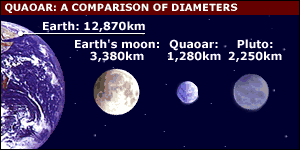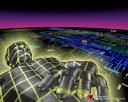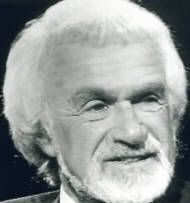QUAOAR
What is this? Find #12?
By Dr David Whitehouse
BBC News Online science editor

A new planet-like object has been found circling the Sun more than one and a half billion kilometres beyond Pluto.
Quaoar, as it has been dubbed, is about 1,280 kilometres across (800 miles) and is the biggest find in the Solar System since Pluto itself 72 years ago.
The object is about one-tenth the diameter of Earth and circles the Sun every 288 years.
It is half Pluto's size, but apparently larger than the ninth planet's moon, Charon.
"It's about the size of all the asteroids put together," Michael Brown of the California Institute of Technology in Pasadena, US, told BBC News Online. "So this thing is really quite big."
Name vote
Brown and colleague Chadwick Trujillo discovered the new world on 4 June.
They used a telescope at the Palomar Observatory in California and followed-up their discovery with the Hubble Space Telescope.
Astronomers named the new object Quaoar, after the creation myth of the Tongva people who inhabited the Los Angeles area before the arrival of the Spanish and other European settlers.
To the indigenous peoples, Quaoar was the great force of nature that summoned all other things into being.
However, Quaoar is not an official name - at least not yet. In a few months, the International Astronomical Union, astronomy's governing body, will vote on it.
For the moment, the object carries the designation 2002 LM60.
Disc of debris
Images of Quaoar had been captured as long ago as 1982, but it was not recognised as a new world. These past observations are being used to pin down its orbit.
"It could easily have been detected 20 years ago, but it wasn't," said Brown.
A good idea of the size of the new world can be gained from the fact that if all the 50,000 numbered asteroids were combined, the resulting body would still be smaller than Quaoar.
Quaoar lies in the so-called Kuiper Belt, a swarm of objects made of ice and rock that orbit the Sun beyond Neptune. They are considered remnants of the swirling disc of debris that coalesced to form the Solar System about five billion years ago.
"This new discovery fits right in with our expectation that there should be a handful of objects as large as Pluto," said astronomer David Jewitt, of the University of Hawaii.
More out there
Jewitt, with then-colleague Jane Luu, discovered the first Kuiper Belt object just a decade ago.
Researchers say that as larger Kuiper Belt objects turn up, the case for regarding Pluto as a fully fledged planet weakens.
Pluto lies within the Kuiper Belt and is considered by many to be merely among the largest of the bunch, and not a planet in its own right.
"It's pretty clear, if we discovered Pluto today, knowing what we know about other objects in the Kuiper Belt, we wouldn't even consider it a planet," said Brown.
Frank Summers, an astrophysicist at the Space Telescope Science Institute in Baltimore, added: "An observation like this just confirms that; that we may discover Kuiper Belt objects bigger than Pluto."
However, there are a great many astronomers who would oppose any notion that Pluto be demoted.
Large world found beyond Pluto
By Dr David Whitehouse
BBC News Online science editor

A new planet-like object has been found circling the Sun more than one and a half billion kilometres beyond Pluto.
Quaoar, as it has been dubbed, is about 1,280 kilometres across (800 miles) and is the biggest find in the Solar System since Pluto itself 72 years ago.
The object is about one-tenth the diameter of Earth and circles the Sun every 288 years.
It is half Pluto's size, but apparently larger than the ninth planet's moon, Charon.
"It's about the size of all the asteroids put together," Michael Brown of the California Institute of Technology in Pasadena, US, told BBC News Online. "So this thing is really quite big."
Name vote
Brown and colleague Chadwick Trujillo discovered the new world on 4 June.
They used a telescope at the Palomar Observatory in California and followed-up their discovery with the Hubble Space Telescope.
Astronomers named the new object Quaoar, after the creation myth of the Tongva people who inhabited the Los Angeles area before the arrival of the Spanish and other European settlers.
To the indigenous peoples, Quaoar was the great force of nature that summoned all other things into being.
However, Quaoar is not an official name - at least not yet. In a few months, the International Astronomical Union, astronomy's governing body, will vote on it.
For the moment, the object carries the designation 2002 LM60.
Disc of debris
Images of Quaoar had been captured as long ago as 1982, but it was not recognised as a new world. These past observations are being used to pin down its orbit.
"It could easily have been detected 20 years ago, but it wasn't," said Brown.
A good idea of the size of the new world can be gained from the fact that if all the 50,000 numbered asteroids were combined, the resulting body would still be smaller than Quaoar.
Quaoar lies in the so-called Kuiper Belt, a swarm of objects made of ice and rock that orbit the Sun beyond Neptune. They are considered remnants of the swirling disc of debris that coalesced to form the Solar System about five billion years ago.
"This new discovery fits right in with our expectation that there should be a handful of objects as large as Pluto," said astronomer David Jewitt, of the University of Hawaii.
More out there
Jewitt, with then-colleague Jane Luu, discovered the first Kuiper Belt object just a decade ago.
Researchers say that as larger Kuiper Belt objects turn up, the case for regarding Pluto as a fully fledged planet weakens.
Pluto lies within the Kuiper Belt and is considered by many to be merely among the largest of the bunch, and not a planet in its own right.
"It's pretty clear, if we discovered Pluto today, knowing what we know about other objects in the Kuiper Belt, we wouldn't even consider it a planet," said Brown.
Frank Summers, an astrophysicist at the Space Telescope Science Institute in Baltimore, added: "An observation like this just confirms that; that we may discover Kuiper Belt objects bigger than Pluto."
However, there are a great many astronomers who would oppose any notion that Pluto be demoted.

















<< Home